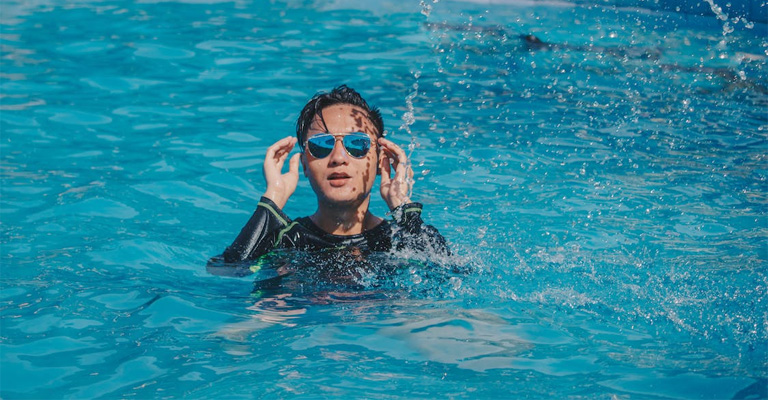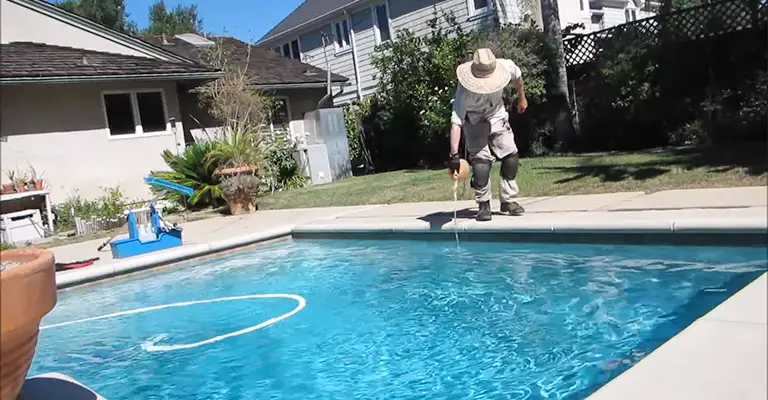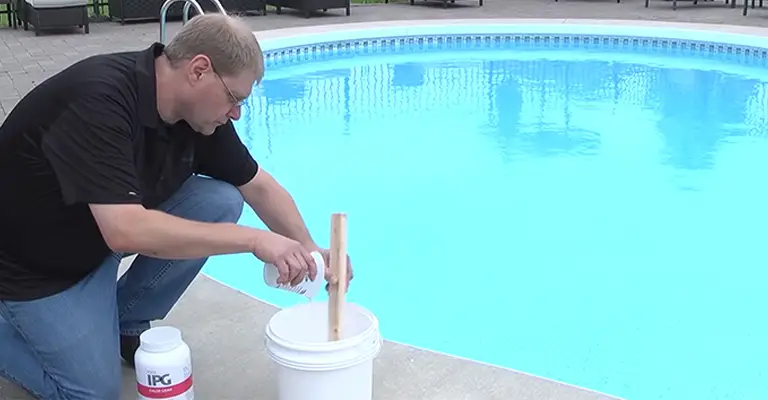Ah, the refreshing bliss of a cool pool on a hot summer day. As pool owners, we understand the importance of maintaining clean and clear water to ensure a safe and enjoyable swimming experience.
One essential aspect of pool maintenance is shocking, which involves adding chemicals to kill bacteria, algae, and other contaminants. However, many pool owners wonder, “When can I swim after shocking my pool?”
It’s generally recommended that you wait up to 24 hours before getting in a pool that’s been shocked. On the minimum range, to swim in your pool after adding chlorine shock, you should wait at least 8 hours.
A chemical test kit can be used to check your chlorine and pH levels to be sure they’re in balance. Check that your free chlorine level has been reduced to less than 5ppm.
Pool shockers work by raising the level of free chlorine in a pool to the point where algae and bacteria are killed.
When you supervise pool maintenance, ensure the pH and chlorine levels are within the proper range before you or anyone else enters the water.
There should be a chlorine concentration of 1.0 to 4.0 parts per million, and a pH of 7.2 to 7.8 is a good value.
Swimming Too Soon After a Pool Shock
The situation may pose a few challenges. Water reacts with chlorine to produce an acid. The effects will differ if chlorine is inhaled or comes in contact with skin or eyes.
It is almost certain that you will suffer from dry skin. It is even possible to experience burning, redness, pain, and blisters as a result of this disorder. Additionally, the water can cause problems for your eyes and lungs.
Eye effects include irritation, redness, blurred vision, and watery eyes. There is usually some sort of respiratory illness associated with inhalation, including shortness of breath, chest tightness, wheezing, and fluid in the lungs.
Additionally, if you accidentally drink pool water, you may feel nauseous or even throw up.
However, the effects of these drugs are usually reversible. Get out of the pool right after it’s been shocked if you notice symptoms and leave the pool immediately.
Take off all exposed clothing and wash all affected areas thoroughly with soap and water. Also, she recommended that you remove your contacts and rinse your eyes thoroughly with saline solution if you wear contacts.
How Long to Wait to Swim After Shocking a Pool?

Your swimming pool will not remain chlorine-free for long if you shock it with chlorine rather than non-chlorine. You can swim shortly after using a non-chlorine shock in your water.
After adding chlorine shock to your pool, you should generally wait at least 8 hours before swimming.
If the free chlorine levels have dropped to 5 ppm (parts per million) or below, swimming is safe.
To ensure your pool water is safe, it is essential to test it before and after shocking, plus your filter needs to be running to circulate the water.
How Long Do I Need to Wait to Swim After Adding Other Pool Chemicals?

In most cases, you can swim within an hour after you add other chemicals to your water. A chlorine shock needs time to circulate and dissipate.
When you add calcium chloride for a higher calcium level, you should wait about an hour for the filter to cycle the chemical through your pool.
In contrast, the dissolving speed of other pool chemicals, such as muriatic acid or flocculant, is dependent on how well they were mixed at the outset.
Ensure your water levels are back within the range of safe levels before swimming.
How Long Should You Run A Filter After Shocking A Pool?
Once you have shocked your swimming pool, run your pool pump and filter for at least 8 hours.
By doing this, the filter will be able to filter the water, and the pump will circulate the chemicals effectively. Ideally, you should run the filter for 24 hours to treat algae.
What Should You Do After Shocking Your Pool?

Allow your filter to circulate the water once the pool has been shocked. Keeping the pump running for at least eight hours after shocking is recommended. Whenever you’re using an unstabilized shock, add shock at night. The shock will then burn off if it is exposed to the sun.
Shock Dissolves After How Long?
Most pool chemicals that adjust levels, including alkalinity, pH, and calcium hardness, dissolve in less than an hour.
In contrast, chlorine-based pool shock takes longer to do its job since it has a powerful, highly concentrated chlorine dose.
The addition of chlorine shocks, such as cal-hypo shock or dichlor, is intended to raise your chlorine levels rapidly.
Increasing chlorine levels above 10 ppm in a short time removes algae, chloramines, and other contaminants.
The high chlorine concentration, though good for killing algae and getting rid of chloramines, isn’t safe for swimming.
In order to avoid health concerns, you need to wait at least 8 hours after adding shock to your water or once your chlorine levels drop to a safe level (ideally 3 ppm or less).
Test your pool’s water chemistry shocking with a test kit or strip after shocking.
The Bottom Line
When dealing with an alga bloom, it is crucial to ensure that the algae are totally removed before entering the pool. When it comes to getting rid of the algae, the time may vary depending on the bloom’s severity.
The best way to rectify your problem is to speak with your local pool professional. Immediately after the shock, your chemical products will work hard to eradicate bacteria and other contaminants from the pool.
Generally speaking, swimming in a pool 24 hours after shocking it is safe. Use a chemical test kit to ensure that your chlorine and pH levels are balanced. If you have a free chlorine level exceeding 3 ppm, you should reduce it.








